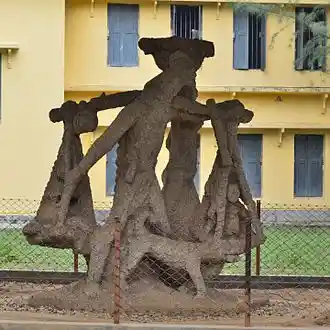The Man Who Created Magic out of Mortar
A peek into the life of Ramkinkar Baij, a sculptor from Bankura, who was an important facet of the Bengal School of Art, as well as in the art history of Santiniketan. Most importantly, he was a man from an economically backward background who, through his relentless determination and talent, made his name in his niche.

Ramkinkar Baij. Source: JNAF
Born in 1906, Ramkinkar Baij hailed from Bankura. He belonged to a family that was, at best, economically modest, but this is a story of how that never stopped him from finding his voice through art.
From a young age, Baij started exploring the materials that were available to him and toiled to create art out of them -- from gravel to cement, he made wonders out of them all. Having grown up watching many local craftsmen deep in work, creating figures, idols, and images, inspired Baij to start experimenting with small figurines and paintings. It was his sheer artistic talent and flawless execution of the same that got him to be noticed by the renowned journalist, Ramananda Chatterjee.
Chatterjee’s advice got Baij to enrol in the art school at Santiniketan, better known as Kala Bhavan. Here, his artistic sensibilities reached new heights under the guidance of Nandalal Bose. The environment of Kala Bhavan encouraged (and still does) liberating intellectual thinking and the freedom of expression and this helped Baij give shape to his passion. Soon, he joined the faculty team after completing his course of study.
Reaching this new complexity and understanding of his art, Ramkinkar Baij, along with Nandalal Bose and Benode Behari Mukherjee, played a very central and important role in turning Santiniketan to be the main centre of Modern Art in the Pre-independence era.
Santiniketan is the place that allowed artists to experiment and revive the art. It allowed talented individuals to bring their visions to life, to tell a story, be it personal, political or social. Baij took to this opportunity to broaden his horizons when it came to his art. He soon began to fill the Kala Bhavan campus with monumental sculptures that were on subject matters close to his heart, expressed in his style. This gave birth to the “Santhal Family” in 1938, a sculptural brilliance that is also considered to be the first public Modernist sculpture in India.
The "Santhal Family" is a sculpture that is larger than life, both in size and context. This artwork talks about the plight of the Santhals, their migration and their emotions. In its rhythmic expression, telling the story of the couple with their child and dog, the whole family is brought to life.
The Santhals get the representation of an iconic presence and grace in the art that was usually reserved for the mighty and the wealthy. In a time and country where all public art was Government commissioned work with a conservative understanding of art by the ruling elites, this was a game-changer.
Baij is thus known for talking about people, places and rural stories of the land through his work. He envisioned a world with no technological invasion but Nature as the central force in life. From buffaloes playing in the mud to the Santhals enjoying a warm afternoon in their cot, his art told stories that were simple and spoke of the day-to-day lives of the native people -- infinitely domestic and tender, yet underlaid with messages that were important and needed attention.
His style and portrayal were always ahead of his time, and his use of indigenous materials and everyday matter like cement and laterite mortar was and will always be unique.
His art and sculptures were reviewed, loved and appreciated by many art connoisseurs and he received invitations to participate in the prestigious Salon des Réalités Nouvelles and Salon de Mai in 1950 and 1951 respectively. In his seventies, he was flooded with national recognition with high honourable mentions coming his way.
He received the Padma Bhushan in 1970, a fellowship at Lalit Kala Akademi and confer as Desikottama by Visva Bharati in 1976 and an honorary D.Litt. by Rabindra Bharati University in 1979.
Ramkinkar Baij left us on 2nd August 1980, but he left behind a treasure chest of monumental learning. His thought-provoking art initiated important conversations and addressed issues that were often overlooked, and his determination and devotion towards his work taught us resilience and the sheer power of motivation. To this date, Baij's use of unusual materials urges us to open our minds and look around ourselves so that we too can find impossible beauty in the mundane, and create out of the ordinary something truly, wonderfully extraordinary.

The Santal Family made in 1938, Santiniketan. Source: Wikimedia commons


